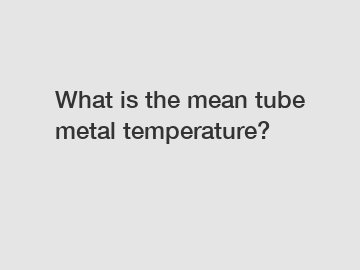What is the mean tube metal temperature?
What is the Mean Tube Metal Temperature?
In many industries, heat exchangers play a crucial role in various processes, such as power generation, chemical manufacturing, and oil refining. One important aspect that engineers and operators need to consider when designing and operating heat exchangers is the mean tube metal temperature (MTMT). The MTMT is a key parameter that directly affects the performance and integrity of a heat exchanger. In this article, we will explore what the MTMT is and why it is significant in heat exchanger operations.
Understanding the Mean Tube Metal Temperature.

The mean tube metal temperature refers to the average temperature experienced by the metal tubes within a heat exchanger. It is calculated by considering the temperature difference across the walls of the tube and the fluid flowing through it. This temperature is critical because it governs the rate of heat transfer between the fluid and the tube, which, in turn, affects the overall efficiency of the heat exchanger.
Factors Affecting the Mean Tube Metal Temperature.
Several factors influence the MTMT, and it is important to consider these during the design and operation of heat exchangers. Some of the key factors include:
1. Inlet and Outlet Temperatures: The temperature of the fluid entering the heat exchanger and the desired outlet temperature play a significant role in determining the MTMT. The greater the temperature difference, the higher the MTMT will be.
2. Fluid Properties: Different fluids have different heat transfer coefficients, which affect the MTMT. The thermal conductivity, viscosity, and specific heat capacity of the fluid influence the heat transfer rate and, consequently, the MTMT.
3. Flow Rate: The rate at which the fluid flows through the tubes also affects the MTMT. Higher flow rates tend to result in lower MTMT values, as the fluid spends less time in contact with the tube surface, reducing heat transfer.
Significance of the Mean Tube Metal Temperature.
The MTMT has several implications for the performance and integrity of a heat exchanger. Firstly, it determines the heat transfer rate between the fluid and the tube. Heat transfer efficiency is crucial in maximizing the performance of the heat exchanger and achieving the desired temperature change. Secondly, the MTMT affects the thermal stresses experienced by the tube. High temperature gradients and fluctuations can lead to mechanical failures, such as thermal fatigue or creep deformation. Therefore, maintaining the MTMT within safe limits is essential to prevent damage and improve the overall lifespan of the heat exchanger.
Conclusion.
The mean tube metal temperature is a critical parameter that directly influences the performance and integrity of heat exchangers. It is determined by several factors, including inlet and outlet temperatures, fluid properties, and flow rate. By understanding the significance of the MTMT, engineers and operators can design and operate heat exchangers more effectively, optimizing heat transfer efficiency and reducing the risk of mechanical failures. For more information about heat exchanger design and operation, feel free to contact us.
Contact Us: [Your Contact Information].
For more information, please visit porous metal, stainless steel medical square plate material, titanium sintered filters.
261
0
0

Comments
All Comments (0)